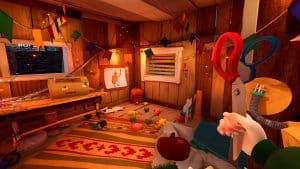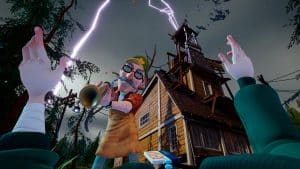Hello Neighbor 2
Related Games
Description
🔥 What is Hello Neighbor 2 for PC
Hello Neighbor 2 is a first-person stealth horror game developed by Eerie Guest Studios and published by tinyBuild, serving as a direct sequel to the cult indie hit Hello Neighbor. Set in the eerie, toy-like town of Raven Brooks, the game expands on the mystery and tension of the original by turning the entire neighborhood into a living, breathing sandbox filled with secrets, puzzles, and unpredictable AI behavior. Players step into the shoes of Quentin, a curious investigative journalist who returns to the town to uncover the truth behind the missing people including the enigmatic Mr. Peterson, the Neighbor himself.
At its core, Hello Neighbor 2 mixes exploration, puzzle-solving, and stealth mechanics in an open-world environment where every house hides clues to the central mystery. What makes this sequel stand out is its dynamic AI system: the game’s inhabitants learn from your actions, adapt their patrol routes, and respond intelligently to your past behavior, making each attempt to sneak around them more challenging and unpredictable.
The game blends eerie suburban charm with psychological unease, inviting players to question not only the secrets of the town but also their own curiosity. It’s less about jump scares and more about sustained tension, experimentation, and the strange comfort of creeping through someone else’s home at night, hoping you won’t be caught.
👉 Features of Hello Neighbor 2
Open World Investigation
Unlike the confined setting of the original game, Hello Neighbor 2 opens up the entire town of Raven Brooks for exploration. You can move freely between multiple homes, public buildings, and hidden areas, each filled with puzzles and fragments of the story. This freedom makes discovery feel organic and personal you’re piecing together a mystery that only slowly reveals its edges.
The world changes subtly as you progress. New locations become accessible, residents’ behaviors shift, and environmental clues emerge over time, giving the game a sense of continuous evolution rather than fixed levels.
Adaptive AI
The heart of Hello Neighbor 2 lies in its advanced AI system. Every character in the town, not just the Neighbor, learns from your tactics, making repeated approaches less effective. If you always enter through a certain window, you might find it locked the next time you return, or the resident waiting nearby.
This dynamic adaptation pushes players to be creative, to think on their feet, and to approach each infiltration as a unique puzzle. The AI’s unpredictability also keeps tension alive, since you can never be entirely sure what the other characters will do next.
Sandbox-Style Exploration
Hello Neighbor 2 moves away from linear mission design and embraces a sandbox approach where the player chooses the order of investigation. You decide which house to enter first, which clue to follow, and how to combine found items to open new paths. There’s a sense of discovery reminiscent of childhood curiosity, where every locked door feels like an irresistible challenge.
Puzzles are often environmental, requiring players to pay attention to small details: a misplaced photo frame, a light switch, or a hidden attic door can lead to entirely new story threads.
Story-Driven Mystery
While the gameplay focuses on exploration, the narrative slowly unfolds through found objects, notes, and subtle environmental storytelling. You’re not just sneaking around for the thrill you’re uncovering the dark history of Raven Brooks and the secrets behind its missing residents.
The writing keeps things ambiguous, encouraging players to form their own interpretations. The mix of mystery, fear, and discovery gives the story a surreal tone, as if everything in the town exists just slightly off from reality.
Enhanced Visual Style and Sound Design
The game retains its colorful, almost cartoonish art direction but enriches it with improved lighting, sharper textures, and a moody atmosphere that shifts from cozy to sinister in an instant. Combined with an eerie soundscape creaking floors, distant footsteps, sudden silences it creates a tension that doesn’t rely on gore but on anticipation and curiosity.
Gameplay
Stealth and Strategy
At first glance, Hello Neighbor 2 seems simple: sneak into houses and uncover secrets. But beneath that premise lies a surprisingly deep system of timing, distraction, and observation. Every house is a mini-labyrinth filled with locked doors, hidden keys, and unpredictable residents. You’ll need to plan routes, study AI behavior, and use the environment to stay unseen.
Getting caught doesn’t always mean failure it often resets the scenario slightly, letting you try again with more knowledge. The tension comes from the uncertainty of when and how you’ll be discovered.
Exploration and Puzzles
The puzzles in Hello Neighbor 2 are logical yet delightfully cryptic, often involving multi-step solutions that combine items and environmental clues. You might need to find a way to reach a high shelf using objects scattered around, or decode a pattern that reveals a hidden compartment. Progress often requires patience and experimentation rather than brute force.
Exploring houses also uncovers layers of environmental storytelling. A cluttered kitchen or a locked basement can speak volumes about its owner, adding emotional context to what you’re discovering.
AI Interaction and Replayability
Because the AI remembers and reacts to your actions, every playthrough feels slightly different. This dynamic creates natural replay value: one route might be safe in your first attempt but guarded in the second. It’s a design that rewards persistence and experimentation, keeping the experience fresh even after multiple tries.
The open-world design means you can revisit old locations to find missed items or clues that only make sense after later discoveries. This looping structure fits the game’s investigative tone perfectly it feels like detective work where intuition and pattern recognition matter as much as skill.
Graphics
Stylized Realism
Hello Neighbor 2 keeps its signature art style that mixes exaggerated proportions and vivid colors with a realistic lighting engine. This blend creates a surreal suburban atmosphere that feels both inviting and uncanny, as if something terrible hides beneath the perfect lawns and cheerful facades.
The visual design supports the game’s dual nature: bright enough to seem harmless at first glance, yet shadowed in a way that unsettles you the longer you look. The contrast between playful art direction and underlying dread is what makes the aesthetic so memorable.
Lighting and Environmental Detail
Lighting plays a major role in shaping the game’s tone. Dynamic shadows, flickering bulbs, and creeping twilight make Raven Brooks feel alive and unpredictable. The interiors are packed with clutter and small decorative touches that make each home feel distinct, hinting at the personality of its owner.
Weather effects like fog and rain also change the mood and visibility, subtly influencing how you approach stealth and exploration. These atmospheric shifts add depth to the world without drawing attention away from the main gameplay loop.
Animation and Sound Design
Character animations are expressive and slightly exaggerated, fitting the stylized visuals while enhancing tension during close encounters. The Neighbor’s movements fast, erratic, sometimes oddly human contribute to his eerie unpredictability.
The sound design amplifies the suspense. Footsteps echo through empty hallways, clocks tick a bit too loudly, and the music ramps up subtly as you approach danger. Every creak feels meaningful, forcing players to listen as carefully as they look.
Pros and Cons
✔️ Pros
- Open-world structure that encourages creative exploration and non-linear problem-solving
- Adaptive AI that learns from player actions and keeps each attempt unpredictable
- Distinctive visual style combining bright suburbia with eerie undertones
- Engaging puzzles that blend environmental clues with logical challenges
- Immersive sound design that heightens tension without relying on cheap scares
❌ Cons
- Inconsistent AI behavior can sometimes break immersion
- Occasional technical bugs and frame drops on PC
- Story remains vague and leaves many questions unanswered
- Some players may find the pacing too slow or direction too unclear
ℹ️ Game information
⭐ Installation Instructions
- The game is fully complete, you just need to install it, so there is no need to unpack it or download it from other sources.
- Just run the Hello Neighbor 2.exe installation file.
- Simply launch the game from shortcut desktop.
⚙️ System Requirements
✅ Minimum:
- OS: Windows 10/11 64bit
- Processor: Intel i3 4th gen / AMD Athlon X4 880K
- Memory: 6 GB RAM
- Graphics: GeForce GTX 750 Ti / AMD Radeon HD 7850
- DirectX: Version 12
- Network: Broadband Internet connection
- Storage: 20 GB available space
✅ Recommended:
- OS: Windows 10/11 64bit
- Processor: Intel i5-4760 / AMD FX 9370
- Memory: 16 GB RAM
- Graphics: GeForce GTX 1660 Ti / AMD Radeon RX Vega 56
- DirectX: Version 12
- Network: Broadband Internet connection
- Storage: 20 GB available space
Images







